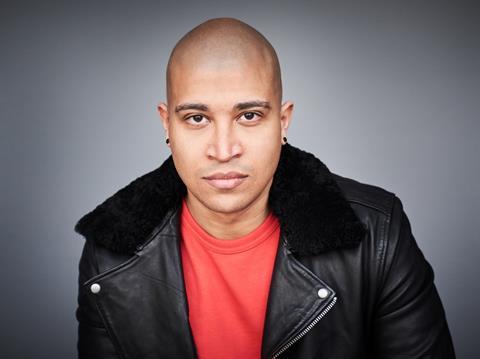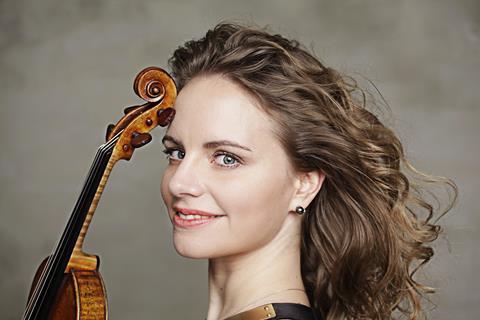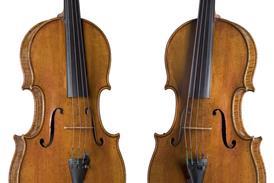British composer Daniel Kidane speaks to The Strad about writing his first violin concerto, inspired by his personal reactions to current political situations such as UK arts funding cuts and the war in Ukraine

Discover more Featured Stories like this in The Strad Playing Hub
On 16 March, German violinist Julia Fischer will premiere British composer Daniel Kidane’s first violin concerto, Aloud, alongside the London Philharmonic Orchestra conducted by Edward Gardner. Kidane speaks to The Strad about the inspiration behind the concerto, how it reflects his personal response to current political issues and writing for the violin as a violin player himself.
Tell us about the influence behind this new concerto
It’s called Aloud and it’s supposed to be a sort of shouting out. It’s a reflection of the situation of the past year or so, including the hardship of the arts in the UK and funding cuts. I wanted to write something similar to when you sort of silent scream in frustration. And in terms of the music, I knew I wanted to write something energetic.
There’s also a secret Cossack tune in it, called Chorni Voron, or Black Crow in Russian. It’s about a fallen Cossack laying on the ground, singing about a crow circling about his head. He’s saying, ‘Why are you circling above my head, I’m not ready to die.’ That fighting energy is present in the piece.
I’m half Russian and my partner is Ukrainian, so the piece also reflects the frustration at the unfortunate situation that the people of Ukraine find themselves in. And on top of that, people in Russia can’t speak out about it for fear of being locked up, while people are being sent to war. I have a second cousin who was sent to war, and unfortunately died within a year. It really affects families. So there’s that element to it too.
What made you want to write something that ‘shouts out’?
As composers, you tend to reflect what is around you. Even though we’re creatives, we don’t live in a bubble. The outside world affects our music, thoughts and how we feel in that moment. Especially when there is conflict. It also coincided with Covid lockdowns and other things going on, so this perfect storm of ideas came together to create this piece.
How does this idea of ‘shouting’ translate musically?
For me it’s always important to have some sort of drive – this idea that the energy, even if it’s quiet, is always there, whether it’s in the notes, rhythm or orchestration. I don’t like standing still. So even though there’s a gap between the two sections, there’s still energy bubbling away setting up the second section.
How is the piece structured?
The overall structure is fast-slow-faster, but it can be divided into two parts. The first half is energetic, yet not as frenetic as the second, and in between these two fast movements there is a slower reprieve. In the first section’s introduction, there is a veiled rendition of the folk tune. The orchestra begins to come to life like an engine revving up before a ‘bang’, and then into a moto perpetuo that drives the piece. There’s also a nod to the folk song in terms of style. So it has a sort of rustic, almost Slavic feel to it, with a tambourine, and other interesting percussion instruments.
The second movement is quite wild. There’s this visceral feel, almost ‘Birtwhistle-y’ in style. It’s a bit less well-behaved than the first section. And stylistically I’d say it fits within the British contemporary genre of new music. It’s gritty and fearless, especially in this wild movement. It has something to say. Again, it quietly reflects the frustrations of the UK policies towards the arts and classical music.

How is the folk song integrated into the work?
It’s hidden and buried within the lines, and it reflects the sort of fighting spirit of the piece. After its veiled rendition at the start, it meanders into other realms. I’ve masked it in different harmonies and augmented its rhythms and so on. It never appears in its original state. If I didn’t tell people, they wouldn’t know it’s there, so it’s a kind of easter egg!
How does this piece fit the concerto form?
I wouldn’t call it a traditional concerto. It’s more of a dialogue between orchestra and violinist, where they come together at times or coincide in different realms or strata. As for how the violin and orchestra interact, at some points they are complementing each other and other times they’re almost battling and arguing. In my experience as a violinist when playing concertos, there would be this idea of the violin having room to speak, but I wanted to almost subvert that idea, which is where the orchestra is speaking over the violin. It’s difficult to do that though, because then you can’t hear the violin! So it has to be managed.
As a violinist, how do you find writing for the instrument?
It’s taken me a long time to be happy to write for it. I needed to create some distance between being a player and composing for it, because I was so familiar with the repertoire, and I didn’t want to reference anything in my pieces. So the idea of trying to create something new and fresh for the instrument is difficult.
As for the violin as an instrument in this work, sometimes it needs to sing and sometimes it needs to be rough and ready. There are parts where the performer needs to bring different flavours out of the instrument, so hopefully Julia is prepared to be a bit rustic in some parts!
The world premiere will take place on 16 March at London’s Royal Festival Hall
Read: ‘You get your favourites as a composer’ - Brett Dean on his Ivors-nominated Cello Concerto
Read: Dragonflies, monsoons and the Somali Jet inspire a new violin concerto for Johan Dalene
Read more Featured Stories like this in The Strad Playing Hub
The number one source for playing and teaching books, guides, CDs, calendars and back issues of the magazine.
In The Best of Technique you’ll discover the top playing tips of the world’s leading string players and teachers. It’s packed full of exercises for students, plus examples from the standard repertoire to show you how to integrate the technique into your playing.
The Strad’s Masterclass series brings together the finest string players with some of the greatest string works ever written. Always one of our most popular sections, Masterclass has been an invaluable aid to aspiring soloists, chamber musicians and string teachers since the 1990s.
American collector David L. Fulton amassed one of the 20th century’s finest collections of stringed instruments. This year’s calendar pays tribute to some of these priceless treasures, including Yehudi Menuhin’s celebrated ‘Lord Wilton’ Guarneri, the Carlo Bergonzi once played by Fritz Kreisler, and four instruments by Antonio Stradivari.





































No comments yet